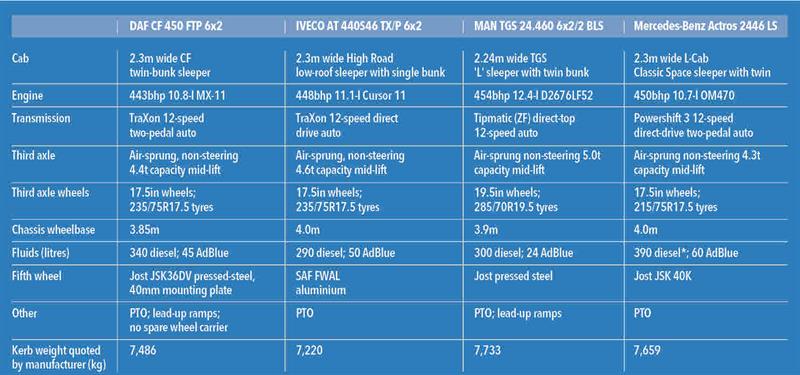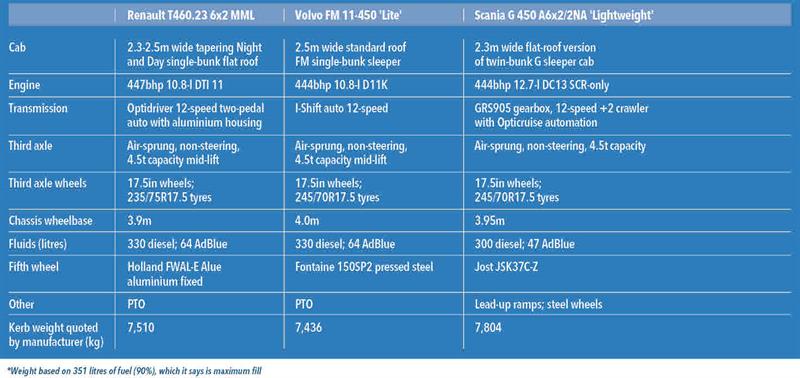With quality, weight and price as its main purchasing criteria, 4R Group bought a Volvo FM11 Lite 6x2 tractor unit to haul a D-Tec tanker last year (pictured above). The vehicle, its first 44-tonner, is collecting liquid waste from anaerobic digestion plants around South Wales and Gloucestershire. In choosing the vehicle, Rick Aldridge, 4R Group’s south operations manager, says: “We were governed by the weight of our new tanker trailer’s 29,500-litre capacity, and Volvo’s FM11, with its lightweight pusher axle, fitted the bill.”
This tractor – lightweight but capable of full 44t gvw haulage – could in fact come from any of the manufacturers. So, for this article, they were polled for sample truck specifications: see table, below. Although the tare weights provide interesting reading, few, if any, operators will buy a truck based on one single figure – whether it’s tare, fuel economy, price or residual value.
But if maximum payloads are a must, then the sub-8-tonne tares of all seven tractors (without the luxury of alloy wheels) in our review are certainly attractive. That’s particularly true because the average 44-tonne high-roof/full-width sleeper cab tractor now weighs around 8.5 tonnes – with some closer to nine – not least thanks to heavier emission-control systems and all the paraphernalia they involve.
Speccing 17.5in or 19.5in wheels on a middle axle can alone save up to half a tonne, while those manufacturers able to offer a narrower 2.3m-wide cab above an 11-litre engine are also well placed. Operators not persuaded by the current trend towards engine downsizing (see https://is.gd/miwutu) probably won’t be bothered by the heavier 13-litre diesels fitted in the MAN and Scania chassis.
In conclusion, don’t let anyone tell you that lightweight tractors with smaller wheels on their middle axle are only for tippers or tankers. While they clearly provide extra chassis space for bigger fuel tanks and other ancillary kit compared with a conventional 6x2, these light tractors also require less diesel to go back down the road when empty. And with the price of derv creeping back up again, that’s real fuel for thought.
THE SMALL PRINT
To be sure we were comparing apples with apples, our low-tare tractor must be suitable for 44-tonne work, so a three-axle chassis was the inevitable default. Next, with weight savings in mind, it should ideally have an engine with a nominal 10- to 12-litre displacement pushing out between 430-475bhp.
While we left the transmission choice open, we insisted that all contestants should have a flat roof (or nearest equivalent) sleeper cab without top or side deflectors. Moreover, any quoted kerb weight should be based on a chassis with a 300-litre fuel tank, or the alternative with the closest capacity, full of fuel and AdBlue typically fitted to a tractor that returns to base most, if not all, nights. Lightweight fifth wheel couplings are noted, as well as lead-up ramps if fitted. All weight calculations assume an 85kg driver. Finally, our tractor had to come with steel wheels to ensure uniformity. However, alloy fuel and air tanks were permissible.

